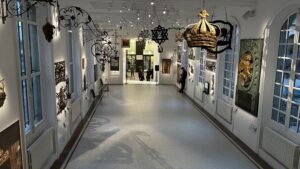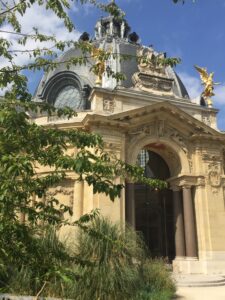Museums in Paris typically aren’t cheap, with adult ticket prices often ranging between $15 and $20, depending on the exchange rate. There are, however, a number of absolutely wonderful museums in Paris that are also absolutely free.
Here are some that I highly recommend:

 The Musée Carnavalet. This Paris history museum is housed in two gorgeous 17th-century mansions in the Marais district. One of its highlights greets you as soon as you walk in: a collection of shop signs, some dating back to the Middle Ages. Another of my favorite rooms is an intact Art Nouveau jewelry store designed by Alphonse Mucha. Several beautifully decorated rooms, some imported from other mansions, illustrate how the upper crust lived in previous centuries. Downstairs you can see prehistoric tools as well as statues, jewelry and other remnants of Paris’ time as a Roman settlement. Upstairs there’s an extensive collection of Revolution memorabilia as well as maps, models, paintings and other exhibits illustrating the city’s history. Don’t miss the small but well-curated gift shop for unique items, including magnets shaped like some of those iconic signs.
The Musée Carnavalet. This Paris history museum is housed in two gorgeous 17th-century mansions in the Marais district. One of its highlights greets you as soon as you walk in: a collection of shop signs, some dating back to the Middle Ages. Another of my favorite rooms is an intact Art Nouveau jewelry store designed by Alphonse Mucha. Several beautifully decorated rooms, some imported from other mansions, illustrate how the upper crust lived in previous centuries. Downstairs you can see prehistoric tools as well as statues, jewelry and other remnants of Paris’ time as a Roman settlement. Upstairs there’s an extensive collection of Revolution memorabilia as well as maps, models, paintings and other exhibits illustrating the city’s history. Don’t miss the small but well-curated gift shop for unique items, including magnets shaped like some of those iconic signs.

Petit Palais: The Petit Palais is another Paris museum where the building rivals the artwork. Both it and the nearby Grand Palais are considered outstanding examples of the Beaux-Arts style (think “over the top, more is more” architecture characterized by lots of statues, columns and decoration). The Petit Palais has a fine collection of paintings and sculptures from the 19th and 20th centuries, but I love it for its beautiful interior garden, which you can enjoy while having lunch or coffee in the museum cafe. The Petit Palais is located just off the Champs-Élysées, not far from the Place de la Concorde.

Maison Victor Hugo. You can check out two Paris must-sees with one visit: the Place de Vosges, a prestigious square in the Marais that dates to the early 1600s, and the home of Victor Hugo, who lived in one of its mansions from 1832 to 1848. Hugo wrote a big chunk of “Les Misérables” here and also indulged in a hobby of reworking old Gothic furniture. He wasn’t a bad draftsman, either; his drawings decorate several of the rooms.
Musée de la Vie Romantique. The “Museum of Romantic Life,” dedicated to the Romantic period in French art and literature, is housed in a compound once owned by painter Ary Scheffer in the Pigalle neighborhood, about a 15 minute walk downhill from Sacre Coeur. The writer George Sand attended salons there, and the exhibits include some of her (surprisingly good) landscape paintings as well as a large oil portrait of her. Once again, a highlight is the museum’s garden and cafe–another great place to rest your feet before heading back out onto Paris’ lively streets.
Musée Cognacq-Jay. Another standout museum in the Marais is the former home of Ernest Cognacq, founder of La Samaritaine department store chain, and his wife, Marie-Louise Jay. The museum’s collection focuses on 18th century art, including paintings, sculptures, furniture and decorative arts, but more than half the pictures I took were of the lovely mansion itself.
You can find a list of other free museums at Paris’ official tourism site, along with a lengthy list of museums that are free on the first Sunday of the month (including heavyweights like the Centre Pompidou and the Musée d’Orsay). Some of these free-Sunday tickets must be reserved well in advance, however. If you can’t land a slot at one of the biggies, consider my all-around favorite Musée des Arts et Métiers, a science and technology museum that proves the French invented everything of importance, or Cité de l’Architecture et du Patrimoine, a museum of architecture and monumental sculpture at the Trocadéro.
A tip for families: Children under 18 are typically free even at the more expensive museums. Also, free admission is often extended to people under 26 if they’re residents of European Economic Area countries.

